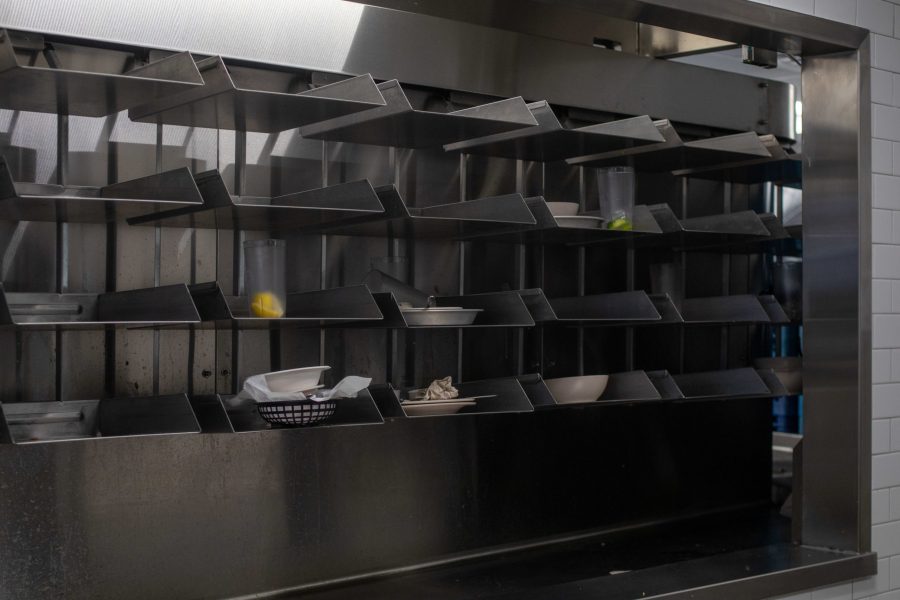Gross: Colorado State requiring meal plans is unfair to students
Collegian | Addie Kuettner
The dining halls on Colorado State University’s campus have thousands of people passing through every day, and it has come into question whether the way these facilities are run and used are clean and if they could cause health concerns, March 9, 2021.
January 31, 2022
Editor’s Note: All opinion section content reflects the views of the individual author only and does not represent a stance taken by The Collegian or its editorial board.
Here’s a joke to start off your spring semester: How do you start a conversation with a freshman? By complaining about the dining hall food.
It’s OK if you don’t get the joke or don’t find it funny. It’s because it’s not really that funny. It’s unfortunate that the lack of quality in the dining hall food has become a joke to Colorado State University students, but it’s the truth. The pandemic-affected food currently being served in the dining halls is disappointing at best and can be borderline inedible at times.
Students living on campus — who are already sinking themselves thousands of dollars into debt — have no choice but to eat dining hall food. There may be no one forcing students to go to the dining halls, but the other options are flawed and often not feasible.
Freshmen can have as much food as they want in their dorms but no way to cook other than a microwave. Microwave ramen can only go so far. How are students supposed to have well-rounded meals when they have no way to cook them?
“There should be an option for students to not purchase a meal plan when they live on campus, or the $1,000 gap should be closed, and students shouldn’t have to pay for the food they don’t eat. The meal swipes don’t roll over, so you’re potentially wasting money if you forgo a meal.”
Each dorm building does have a functional kitchen, but it’s one that several hundred students have to share. Why would someone want to battle it out over using the stove when they could just walk to the dining halls?
Furthermore, why would someone want to pay out of pocket for their own groceries when they’re already paying for food at the dining halls, regardless of whether they eat there? College students are notoriously broke, so spending more money isn’t exactly possible.
The meal plans are ridiculously expensive, too, for how low-quality the food is. The cheapest meal plan is $2,505 a semester for ten meals a week and $150 in RamCash. Each meal swipe equates to about $8 at CSU Express locations.
If a student were to use all 10 meals, worth $8 each, during all 16 weeks of the semester, that comes out to $1,280 spent on food that semester. Factoring in the 15 bonus meals and $150 RamCash that comes with this meal plan, the student is still only spending $1,550 on food in a semester.
There is a difference of nearly $1,000 between what the student is paying for and the value of the meals.
This roughly $1,000 difference continues through the “any 15” and “any 19” meal plans. The “ultimate” meal plan is the only one that, when used fully, ends up costing less than the value of the meals; however, that would require eating eight meals per day, and very few students have the time (or stomach capacity) for that.
“Everyone deserves to be able to have a nice meal at the end of a long day. Right now, CSU isn’t providing this nor allowing students to do it for themselves.”
CSU students already faced the transition of the Durrell Center to only Express and Marketplace functions at the beginning of the fall semester. Options got even more limited upon returning to campus this spring, with the two marketplaces closing three hours earlier than before. With all of these changes, there is potentially unused money, and students should know where that’s going, or have a say in where it’s diverted.
We can’t blame the staff of these dining halls because it is short staffing that is driving these closures, which makes sense considering the effect the United States’ labor shortage has had on the food industry. CSU isn’t even really at fault for the closures themselves — it’s just the reality of living amid a pandemic.
Still, students living on campus are paying the same amount of money for fewer food options as a result.
There are a few glaring problems in these current conditions, so what can be done to make the dining hall situation more bearable?
There should be an option for students to not purchase a meal plan when they live on campus, or the $1,000 gap should be closed, and students shouldn’t have to pay for the food they don’t eat. The meal swipes don’t roll over, so you’re potentially wasting money if you forgo a meal.
This change would encourage more students to go out, buy their own groceries and use the kitchens provided. Having an extra $1,000 can go far when buying food — much further than the same meals served on repeat in the dining halls. The other way this can be fixed is by simply making the dining hall food better, even if the pandemic makes it difficult. If we raise food quality standards and diversify what’s being served, then students might actually want to go and eat in the dining halls.
Everyone deserves to be able to have a nice meal at the end of a long day. Right now, CSU isn’t providing this nor allowing students to do it for themselves.
Reach Dillon Gross at letters@collegian.com or on Twitter @dillongrosss.





